![]()
The "Torrey Canyon" Salvage Attemp
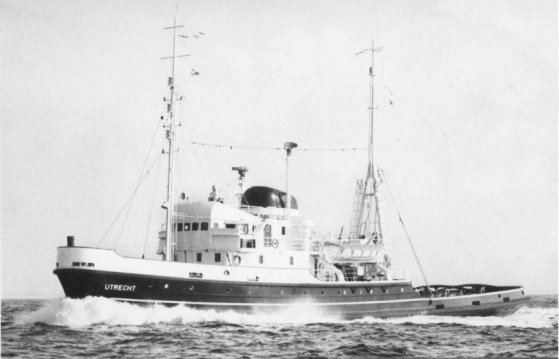
The salvage tug "Utrecht"
"ASHORE ON SEVEN STONES, REQUIRE IMMEDIATE ASSISTANCE".
This message, received on saturday, 18th. march, 1967, heralded the drama surrounding the
118.000 d.w.t. Liberian-registered tanker "Torrey Canyon". Soon afterwards, the
message "NOW PROCEEDING" crackled trough the ether; this was from our salvage
tug "Utrecht" which had already weighed anchor from her station in Mounts Bay
and was on her way to the tanker's position. A salvage operation which, if not the most
difficult, was certainly the most hazardous of the six hundred carried out by the company
since its inception, had begun.
Some hours after the vessel went aground, her owners instructed our Company to undertake
her salvage on the basis of Lloyd's Open Form - no cure, no pay. The action of the
vessel's Master in initially refusing to sign the contract resulted in valuable time being
lost.
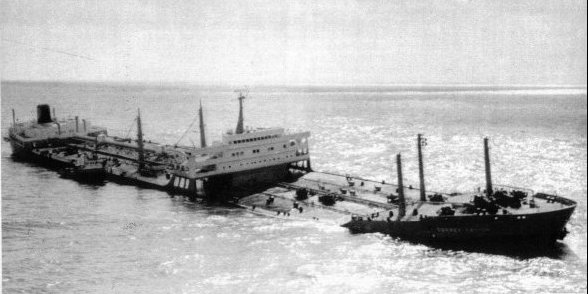
"The "Torrey Canyon"grounded on the Seven
Stones, on saturday 18th. march
The Master's first reports said that seven cargo tanks had been holed and that some 30.000 tons of oil had escaped. In the meantime, two of our other tugs, the "Stentor"and "Titan" had been instructed to leave their positions at Avonmouth and Ymuiden respectively and make for the tanker's position, and the Portuguese tug "Praia da Adraga", bound from Lissabon to Liverpool, was also directed there. The salvage equipment on board the four tugs was supplemented by consignments from Ymuiden; compressors, pumps and generators were taken by road to Schiphol airport, Amsterdam, from where they were flown to Exeter the same evening in three specially chartered planes belonging to Martin's Air Charter. A team of salvage experts headed by Captain H.B. Stal also left by air.
Also the "Stentor"(up) and
"Titan"(below) went to the place of disaster
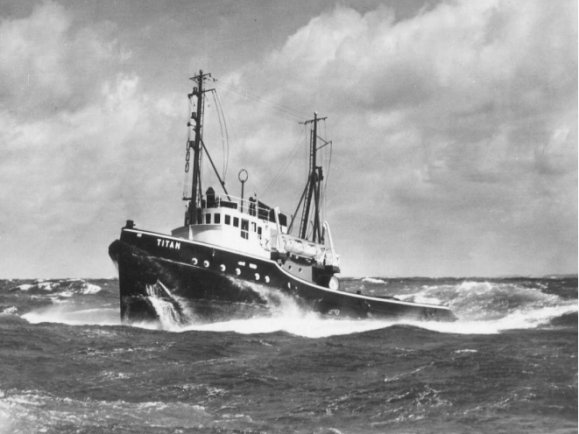
An initial inspection of the "Torrey Canyon" was made on
the following day and this showed that the damage was considerably more serious than had
first been thought: 14 of the 18 cargo tanks had been holed and the rocks had ripped also
trough the bottom plating beneath the forward and aft pumproom and the forward and aft
fuel tanks.
Moreover, seawater and escaping oil from the cargo tanks had penetrated the engineroom via
the aft pumproom. Of the vessel's crew of 36, only the Italian Master and three hands were
still on board; the remainder had been taken off by lifeboats and helicopters and
put ashore. Particularly in view of the vessel's position at one of the most dangerous
points in West European waters as far as weather and swell are concerned, the salvage
operation was mounted with a maximum of equipment and a minimum of delay.
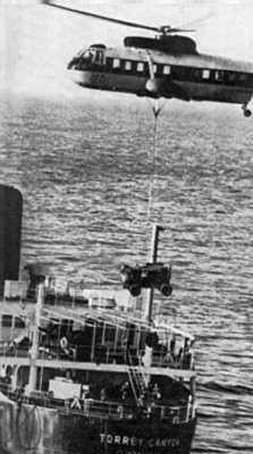 The
equipment sent from Holland was put on board the "Torrey Canyon" by helicopters
on the monday and more, including three heavy compressors which were manhandled on to the
tanker's main deck, was transferred from the tugs.
The
equipment sent from Holland was put on board the "Torrey Canyon" by helicopters
on the monday and more, including three heavy compressors which were manhandled on to the
tanker's main deck, was transferred from the tugs.
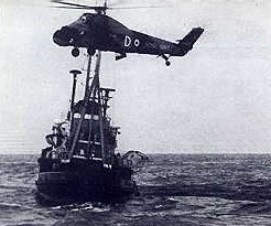
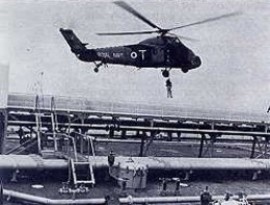
up and right: equipment and salvors flown over by
helicopters from the "Utrecht"
to the "Torrey Canyon
The salvage experts were unanimous in the view - shared by the
British government - that the best chance of preventing the further escape of oil was to
try to salve the tanker in one piece and refloat her. Provided that the weather held out,
the chanches of saving her were at that time reasonable. The salvage crew made rapid
progress on the monday and tuesday. The pricipal task was to seal of all the deck openings
to the tanks in order to be able to put the tanks under pressure by compressed air and so
increasing her buoyancy. Also the hoses were connected from the air compressors to the
steam smuddering line. At the same time we were preparing the big submersible pumps for
the use in the engineroom. at about midday on the tuesday a heavy explosion in the upper
part of the engineroom, which was fortunately deserted at that moment, brought everything
to a standstill. Prompt action by the tug crews resulted in all salvage being taken off
the tanker. Particularly commendable was the action of the sailors F.M van Rixel and A.B.
van Wijk, both of the "Titan", who without hesitation dived into the oil-covered
waves to save Captain H.B. Stal and a member of the crew of the "Praia da
Adraga", who had been flung overboard by the force of the explosion.
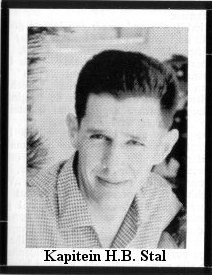 Emergency
action was taken to secure medical assistance for Captain Stal and soon a doctor was
winched down on to the "Titan" from a helicopter. Alas, this efforts were in
vain as Captain Stal died on board the "Titan" as she entered the harbour of
Newlyn near Penzance. His passing was a great blow, particulary to the officers and men
with whom he had worked only hours before. But the effords to salve
the crippled tanker had to go on. Salvage Inspector H. Bijlsma received instructions from
Ymuiden to assume control on the spot. The same afternoon, he conducted a fresh
investigation into the vessel's condition. The only damage was to the upper part of the
engineroom at the point where once the skylight had been. Of fire there was no tace.
Emergency
action was taken to secure medical assistance for Captain Stal and soon a doctor was
winched down on to the "Titan" from a helicopter. Alas, this efforts were in
vain as Captain Stal died on board the "Titan" as she entered the harbour of
Newlyn near Penzance. His passing was a great blow, particulary to the officers and men
with whom he had worked only hours before. But the effords to salve
the crippled tanker had to go on. Salvage Inspector H. Bijlsma received instructions from
Ymuiden to assume control on the spot. The same afternoon, he conducted a fresh
investigation into the vessel's condition. The only damage was to the upper part of the
engineroom at the point where once the skylight had been. Of fire there was no tace.
With the Head of our Technical Department, Mr. P. v. d. Berg coordinating operations from
the shoreside in Cornwall, and acting as a liaison officer between our head office, the
salvage party on board the tanker, the Royal Navy and other British authorities in
Plymouth, work on the tanker was resumed on the wednesday afternoon. Further efforts were
made to make the tanks airtight and connect the hoses which would maintain a cushion of
air in them; moreover, the rise and fall of about 20 ft in the tide was to have been
utilized. Sealing the cargo tank covers at low tide resulted in aubstantial pressure
cushion building up in them during the rising tide and at high tide on thursday, 23rd
march the tanker was more or less afloat but was held fast by rocks which projected high
into the damaged hull; moreover, her list had disappeared. On the followingday, while the
crews were working at full pressure to increase the air cushion in the tanks, the weather
deteriorated. The forecast predicted Force 7 and 8 gales on the friday. On saturday, 25th.
march it was decided to make an attempt to reflote the tanker; all four tugs being
connected on her port side.
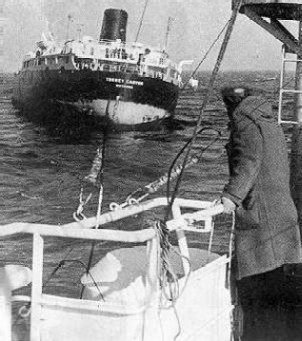
The "Utrecht"came close to the aft stern
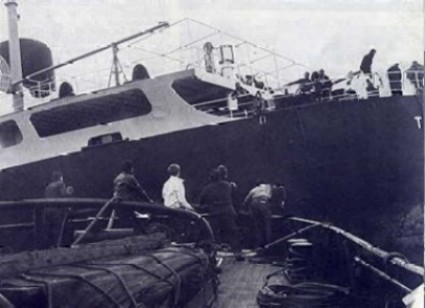
The "Titan" makes coconnection
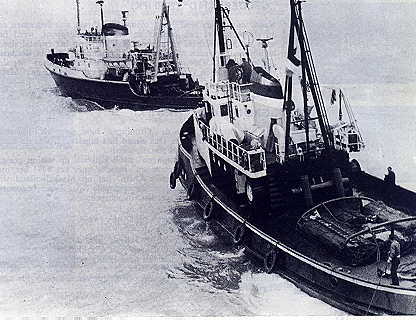
The "Utrecht" and "Titan" seen from the
aft stern
of "Torrey Canyon"
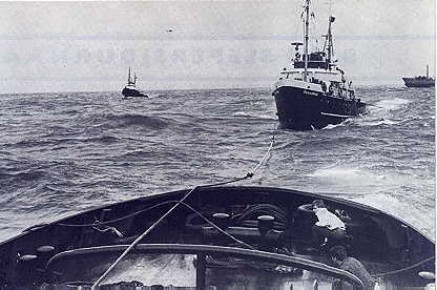
On this photo the "Titan", "Praia de
Adraga"and "Stentor" in an attempt
to reflote the tanker
Another attempt was made on the sunday morning and it was noted that althought she could be swungslightly and was afloat, she was still held fast by thr rocks. It was clear that a greater volume of air was required in the tanks, however bad weather prevented the transfer by helicopter of the salvage crew from the tugs to the tanker (in view of the conditions, operations were only carried on during the daylight hours). In the course of the day the southwesterly wind increased to gale force 8. Heavy seas crashed against the tanker and broke over the entire lenght of her deck. That evening came the first reports of the cracks fat of the bridge. Soon afterwards she broke in two and the stern section began to settle in the water.



Three stages of the tanker: Shortly after grounding, during
the storm
and broken in two after the storm
On Easter monday, the fore part, pounded
by the enormous seas, broke in two. Our managing Director Arthur Wijsmuller, and
our Operating Manager, Mr. F. Jonkman flew over the wreck in an R.A.F. helicopter during
the afternoon. There was still a chance of salving the three sections of the tanker,
however on the morning of tuesday 27th of march, the British Admiralty ordered the tugs to
leave the area. At 9.30 a.m. on that day, we wereforced in view of the circumstances to
abandon the salvage operations.
Shortly afterwards R.A.F. planes were send out to pour bombs and rockets into the
wreck in an attempt to set fire to the remaining oil in the tanks, however the cargo
proved extremely difficult to ignite. All the salvage equipment taken on board the
"Torrey Canyon" was lost.
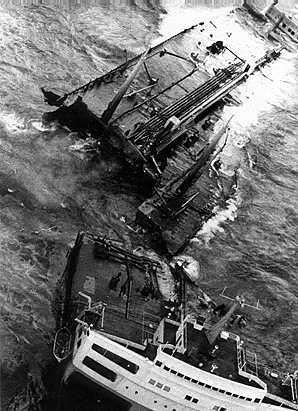
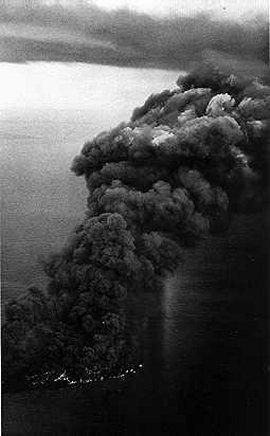
The wreck and burning oil of the "Torrey Canyon"
The fleet of small but gallant ships called
at Newlyn, after which the "Praia da Adraga"set course for Hamburg -- whence she
had in the meantime been directed -- and the "Titan" and "Stentor"
made for theire home port Ymuiden. The "Utrecht" returned to her station at
Mounts Bay.
The operation had ended. The final entry in the log told its own story: No cure.
